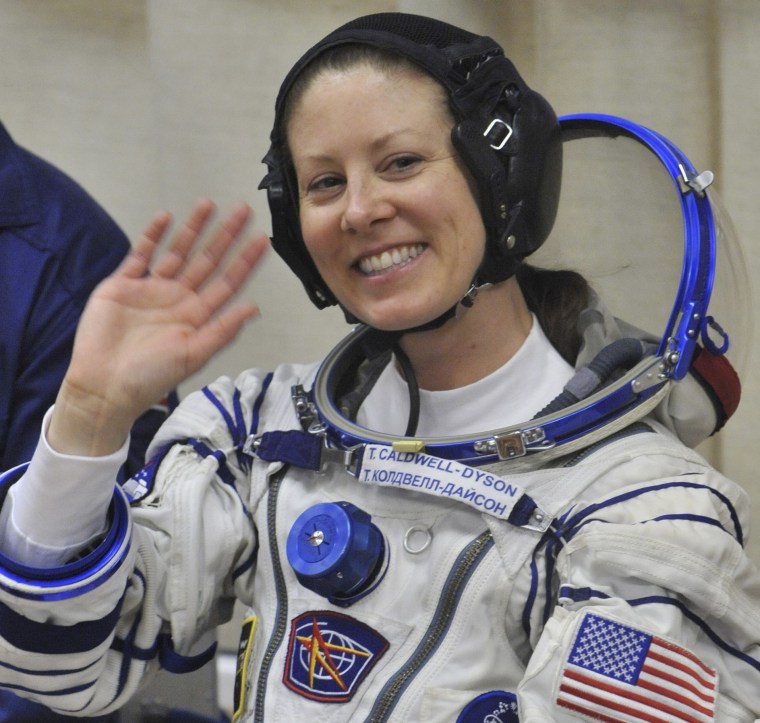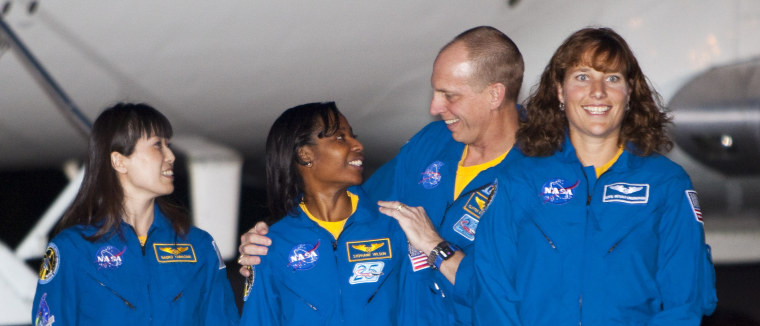Space is about to have a female population explosion.
One woman already is circling Earth in a Russian capsule, bound for the International Space Station. Early Monday morning, NASA will attempt to launch three more women to the orbiting outpost — along with four men — aboard shuttle Discovery.
It will be the most women in space at the same time.
Men still will outnumber the women by more than 2-to-1 aboard the shuttle and station, but that won't take away from the remarkable achievement, coming 27 years after America's first female astronaut, Sally Ride, rocketed into space.
A former schoolteacher is among the four female astronauts about to make history, as well as a chemist who once worked as an electrician, and two aerospace engineers. Three are American; one is Japanese.
But it makes no difference to educator-astronaut Dorothy Metcalf-Lindenburger's 3-year-old daughter Cambria.
"To her, flying is cool. Running around is being cool. Just learning and growing up as a kid is cool. There aren't a lot of distinctions, and that's how I want it to be," said Metcalf-Lindenburger, 34, who used to teach high school science in Vancouver, Wash.
Indeed, the head of NASA's space operations was unaware of the imminent women-in-space record until a reporter brought it up last week. Three women have flown together in space before, but only a few times.
"Maybe that's a credit to the system, right? That I don't think of it as male or female," said space operations chief Bill Gerstenmaier. "I just think of it as a talented group of people going to do their job in space."
Slideshow 12 photos
Month in Space: January 2014
Discovery's crew of seven will spend 13 days in space, hauling up big spare parts, experiments and other supplies to the nearly completed space station. It's one of four shuttle flights remaining. Monday's liftoff time is 6:21 a.m. ET.
Metcalf-Lindenburger and Japanese astronaut Naoko Yamazaki, both rookies, will become the 53rd and 54th women to fly in space — and the 516th and 517th spacefarers, overall. Soviet cosmonaut Yuri Gagarin became the world's first space traveler in 1961. The Soviet Union followed with the world's first spacewoman in 1963: Valentina Tereshkova.
"I'd love to have those numbers be higher," said astronaut Stephanie Wilson, 43, who will be making her third shuttle flight. "But I think that we have made a great start and have paved the way with women now being able to perform the same duties as men in spaceflight."
Wilson became the second black woman in space in 2006; one other has since followed her.
Yamazaki will become the second Japanese woman to fly in space. Dr. Chiaki Mukai was the first in 1994.
Perhaps even more astounding, at least in Japan, Yamazaki's husband quit his space station flight controller's job to follow her career and help care for their 7-year-old daughter.
"It is very rare. In Japan, it's general for men to work and for women to stay at home," Yamazaki, 39, said. Just as she was inspired by Mukai, "hopefully, I can inspire younger women as well."

Rounding out the foursome will be Tracy Caldwell Dyson, who was launched aboard a Soyuz rocket from Kazakhstan on Friday with two Russian men. They will arrive Sunday and settle in for a six-month stay.
Caldwell Dyson, 40, who has a doctorate in chemistry, grew up in Southern California assisting her electrician father. She wasn't sure what to do with her life until she learned that a schoolteacher was reaching for the stars. Christa McAuliffe died trying; she was killed along with six others aboard Challenger in 1986.
McAuliffe, a high school teacher, also inspired Metcalf-Lindenburger, who was 14 years old when she attended Space Camp in Huntsville, Ala., several years after the Challenger launch accident.
Now it's Metcalf-Lindenburger's turn to ride a rocket.
"Of course, the shuttle has its risks. But we've tried to make it as safe as possible, and there are so many things that we gain from it and there are so many reasons to fly it," she said.
Metcalf-Lindenburger was a young earth-science and astronomy teacher when she stumbled onto NASA's want ad for astronaut-educator in 2003. A student had asked how astronauts go to the bathroom in space, and an embarrassed Metcalf-Lindenburger promised to look up the answer.
Today she's no longer fazed by toilet questions.
"My daughter is just potty training, and now I talk about it on a daily basis," she said with a chuckle.

